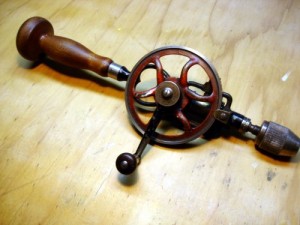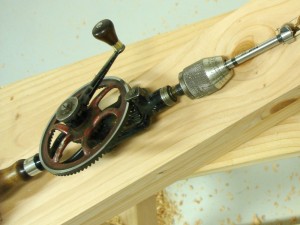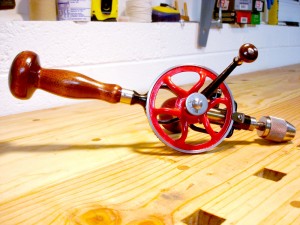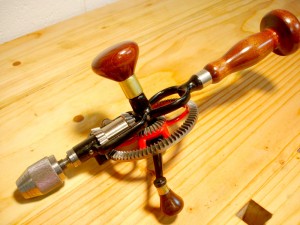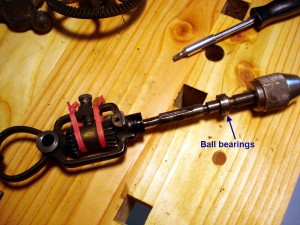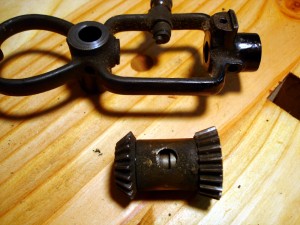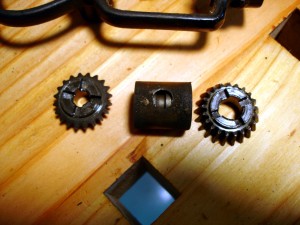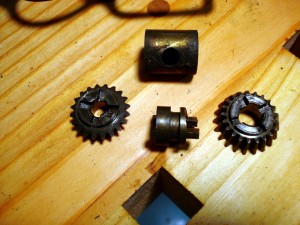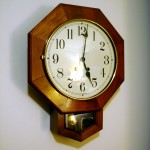 This lull between boat building projects is a good time to complete a project that was set aside a few years ago. Back when the Emperor Clock Company had a very wide range of offerings (1968), I put together a School Clock from their supplies. The case is a design from Albert Neely Hall who produced a great many “Craft Patterns” in the first half of the twentieth century. I built the case from Cherry and installed a mechanical, spring driven movement. The movement is a pendulum regulated 8 day clock. It chimes out “bim-bam” counts on the hour, and a single “bim-bam” on the half hour.
This lull between boat building projects is a good time to complete a project that was set aside a few years ago. Back when the Emperor Clock Company had a very wide range of offerings (1968), I put together a School Clock from their supplies. The case is a design from Albert Neely Hall who produced a great many “Craft Patterns” in the first half of the twentieth century. I built the case from Cherry and installed a mechanical, spring driven movement. The movement is a pendulum regulated 8 day clock. It chimes out “bim-bam” counts on the hour, and a single “bim-bam” on the half hour.
The clock ran for 37 years with virtually no attention, other than winding once a week. Once a year I would stop the clock for an hour for the fall change from Daylight Savings Time to normal time. The change in 2005 didn’t work out so well. Restarting the clock left it running for no more than a couple of minutes. Well, that’s no surprise. 37 years of no maintenance probably means dried out oil and various other bits of accumulated tarnish.
Many horological specialists recommend simply replacing a movement of this age. That’s because the replacement costs less than the (professional) labor needed to clean or repair an old movement. Being neither a horological specialist nor a professional clock restorer, and also discovering that the original manufacturer, Jauch, no longer exists, I decided to ignore that advice and clean and restore it myself.
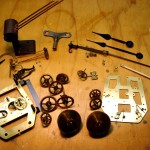 That was back in 2005. I got as far as removing the movement, making some drawings and photos of it, tearing it down to pieces, and then setting it aside until … Did you know that a circlip, an unladen European circlip, can travel up to 20 feet unassisted? … until I found the time to learn enough about what to do next. Most of my learning is thanks to The National Association of Clock and Watch Collectors which has an excellent collection of information and some very helpful forums.
That was back in 2005. I got as far as removing the movement, making some drawings and photos of it, tearing it down to pieces, and then setting it aside until … Did you know that a circlip, an unladen European circlip, can travel up to 20 feet unassisted? … until I found the time to learn enough about what to do next. Most of my learning is thanks to The National Association of Clock and Watch Collectors which has an excellent collection of information and some very helpful forums.
The movement was actually in quite good shape. None of the pivots had excessive wear and there were no other major problems. Cleaning was mostly a matter of ultrasonic cleansing to remove grime and polishing of pivot and bearing points.
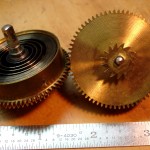 The big challenge, other than flying circlips, was cleaning the drive springs. They are cased in barrels and I was advised to be very careful removing them from the barrels. Stories of springs bounding out of control and slashing through various body parts convinced me to heed the advice. The proper tool for the job is a winder. Commercial versions are available for a mere $200 (plus sleeves, plus shipping, plus etc.). The more affordable answer came in the form of a homebuilt design by Joe Collins, one of the NAWCC members. So, there was a detour to to the woodworking (and metal working) shop to build an instance of Joe’s winder.
The big challenge, other than flying circlips, was cleaning the drive springs. They are cased in barrels and I was advised to be very careful removing them from the barrels. Stories of springs bounding out of control and slashing through various body parts convinced me to heed the advice. The proper tool for the job is a winder. Commercial versions are available for a mere $200 (plus sleeves, plus shipping, plus etc.). The more affordable answer came in the form of a homebuilt design by Joe Collins, one of the NAWCC members. So, there was a detour to to the woodworking (and metal working) shop to build an instance of Joe’s winder.
The winder cost about a tenth of the commercial version and did its job very well. I have no pictures of it in use because controlling the tension of the springs was a lot more important than taking pictures. 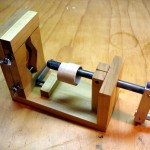 Basically, the sequence is: Clamp the spring barrel in the v shaped jaws. Oh yeah, this is after removing the gear on the end of the arbor, and removing a cap from the barrel, both with their own forms of entertainment. Attach the crank shaft to the winding stem. Crank the spring up tight enough to allow a sleeve to be shoved into the barrel. Unwind the spring into the sleeve. Pull the sleeve, spring contained, out of the barrel. Capture the outside end of the spring with a hook on an arm at the side of the barrel. Tighten enough to allow the sleeve to be pulled away. Lastly, unwind the spring. You can watch Joe demonstrating the winder in a video here. The spring can then be cleaned, polished, lightly oiled and replaced into the barrel by reversing the removal process. Building the winder took quite a few hours. Using it took about 6 minutes.
Basically, the sequence is: Clamp the spring barrel in the v shaped jaws. Oh yeah, this is after removing the gear on the end of the arbor, and removing a cap from the barrel, both with their own forms of entertainment. Attach the crank shaft to the winding stem. Crank the spring up tight enough to allow a sleeve to be shoved into the barrel. Unwind the spring into the sleeve. Pull the sleeve, spring contained, out of the barrel. Capture the outside end of the spring with a hook on an arm at the side of the barrel. Tighten enough to allow the sleeve to be pulled away. Lastly, unwind the spring. You can watch Joe demonstrating the winder in a video here. The spring can then be cleaned, polished, lightly oiled and replaced into the barrel by reversing the removal process. Building the winder took quite a few hours. Using it took about 6 minutes.
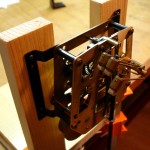 Reassembly was the simple process of putting all the parts back in their proper places (including multiple hunts for flying circlips) and adding very tiny drops of oil only to the pivot points. It’s really handy to have a test stand, making it much easier to put the movement on the stand rather than back in the case for testing. I can now take the movement off the test stand, remove the pendulum and strike levers (3 circlips), separate the plates, adjust wheel positions in the strike train, and put it all back together in about 10 minutes (excluding circlip search and rescue time). That comes from practice. The time train has the larger number of wheels, but is very straightforward. The strike train is another matter. I learned by trial and trial, and trial, that the strike train can be assembled in such ways that the hours strike but the half hours don’t, the half hours strike and the hours don’t, and clock strikes bam-bim instead of bim-bam.
Reassembly was the simple process of putting all the parts back in their proper places (including multiple hunts for flying circlips) and adding very tiny drops of oil only to the pivot points. It’s really handy to have a test stand, making it much easier to put the movement on the stand rather than back in the case for testing. I can now take the movement off the test stand, remove the pendulum and strike levers (3 circlips), separate the plates, adjust wheel positions in the strike train, and put it all back together in about 10 minutes (excluding circlip search and rescue time). That comes from practice. The time train has the larger number of wheels, but is very straightforward. The strike train is another matter. I learned by trial and trial, and trial, that the strike train can be assembled in such ways that the hours strike but the half hours don’t, the half hours strike and the hours don’t, and clock strikes bam-bim instead of bim-bam.
The case got bit of refinishing with danish oil and, of course, the brass and glass got a good cleaning. It’s all back together now (including all circlips), hanging on the wall again, and keeping good time. It’s good to hear the familiar bim-bam once more.
Yes Heidi, your “claim tag” is still firmly attached.
